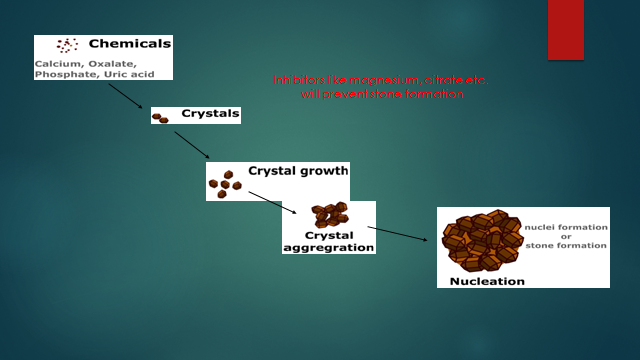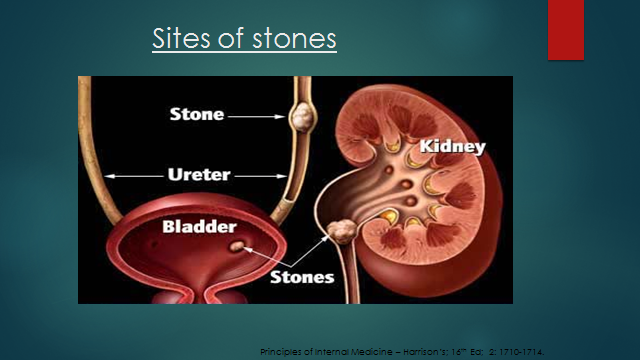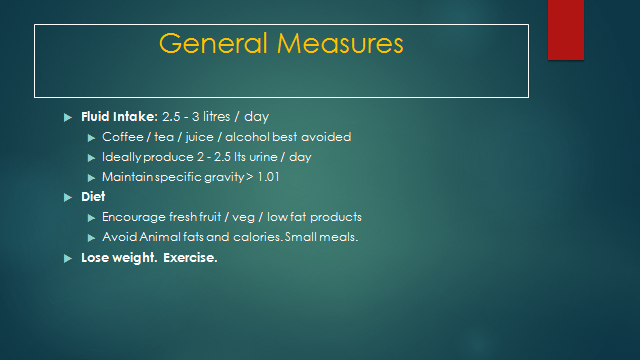Kidney stone
- Written by: Department Of Urology
- Published: March 8, 2023
- 4 min Read
crystallisation of urinary chemicals such as calcium ,oxalate ,phosphate
,magnesium etc in urinary tract(kidney calyx ,pelvis,ureter,bladder,urethra)
Kidney stone formation:


These are the different sites of kidney stone


General measures to prevent stone formation


If kidney stones become lodged in the ureters, it may block the flow of
urine and cause the kidney to swell(stretches the capsule over kidney) and
the ureter to spasm, which can be very painful. At that point, you may
experience these symptoms: Severe, sharp pain in the side and back, below
the ribs. Pain that radiates to the lower abdomen and groin.
Myth 1 - All stones are very painful
Fact – Kidney stones are deposition of minerals that form in the urinary tract
and may cause pain, bleeding, or an infection or block of the flow of urine. But
they’re not always painful, especially when they first form. If the stone is in the
pelvis or calyces or in the bladder, it may not cause pain. The first signs of the
stones may be blood in the urine or minor back pain. In other cases such as
ureteric stone , stones can be excruciatingly painful and cause nausea and
vomiting.
Myth 2 - Larger stones are always more painful
Fact – Size is only one factor in how painful – and potentially dangerous
– a kidney stone can be. The location of the stone is another factor to
consider. A smaller stone in the wrong place such as a ureter can create
a blockage that is incredibly painful and requires a trip to the
emergency room. Depending on the location of the stone, individuals
may feel pain in their back or lower abdomen, or they may experience
renal colic – excruciating, intermittent pain usually in the area between
the ribs and hip on one side of the flank or back that spreads across the
abdomen and often extends to the genital area. The pain tends to come
in waves, gradually increasing to a peak intensity, then fading, over
about 30 to 60 minutes.
Myth 3 - Hydrotherapy helps to flush out urinary calculi
Myth: Drinking copiously will help promote passage of kidney and ureteral
stones. The rationale of this advice is that by hydrating massively, pressure
will be created to help passage of a stone present in the kidney or ureter.
fact: The presence of a stone often causes urinary tract obstruction. Over
-hydration in the presence of obstruction will further distend the already
bloated and inflated portion of the urinary collecting system located above
the stone. This increased distension can exacerbate pain and nausea that
are often symptoms of colic. The collecting system of the kidney and the
ureter have natural peristalsis similar to that of the intestine and
over-hydration has no physiological basis in terms of helping this process
along, being pointless and perhaps even dangerous. Drinking moderately
in the face of a kidney or ureteral stone is sound advice
Myths 4 Everyone must drink 3-4 litres of water a day.
Myth: Many sources of information (mostly non-medical and of dubious
reliability) dogmatically assert that humans need 3-4 litres of water daily to
stay well hydrated and thrive.
fact: Many people who drink a lot of water end up in urologists’ clinics with
urinary urgency, frequency and often urinary leakage especially in old age .
The truth of the matter is that although some urinary issues are brought
on or worsened by insufficient fluid intake–including kidney stones and
urinary infections–other urinary problems are brought on or worsened by
excessive fluid intake. Water requirements are based upon ambient
temperature and activity level. If you are sedentary and in a cool
environment, your water requirements are significantly less than when in
the hot conditions. Heeding your thirst is one of the best ways of
maintaining good hydration status, in other words, drinking when thirsty
and not otherwise. Another method of maintaining good hydration status
is to pay attention to your urine colour. Urine colour can vary from deep
yellow to as clear as water. If your urine is dark yellow, you need to drink
more as a lighter colour is ideal and indicative of satisfactory hydration.
MYTH 5: Restriction of calcium in the diet helps to reduce urinary stone recurrence
Myth: Calcium is a major component of 75% of stones hence many people
believe that restriction of dietary calcium is a logical means of preventing a
recurrence.
fact: Several studies have shown that severe restriction of calcium in the diet
actually increases the recurrence rate of urolithiasis by increasing the oxalate
absorption from the intestine. So calcium should be consumed in moderation
and should not be restricted.
MYTH 6 :There are medicines to dissolve all urinary stones
REALITY: 80% of the urinary stones are composed of calcium oxalate or
calcium phosphate. For these there are no medicines available that can
dissolve the stones.In select patients with small uric acid stones (5 % of stones)
or cystine stones (1-3% of stones), medications can potentially be used to help
dissolve their stones. However, even in these, surgery may be required.
MYTH 7 :Shock Wave Lithotripsy (SWL) can be used to treat renal calculi of any size and form
REALITY: SWL is used to treat only small calculi less than 1.5 cm. If ESWL is
used to fragment larger renal calculi then these fragments may block the
ureter or some of these fragments may remain in the kidney and lead to a
recurrence.. Thus SWL for large renal calculi has poor success rates and is
associated with a high risk of ancillary treatments for the residual calculi. Also
it is not ideal for very hard stones. It cannot be recommended as a universal
treatment for all renal calculi but must be used selectively.
MYTH 8 : All Kidney stones has to be removed
FACT: Many men and women have tiny renal calculi which are detected during
evaluation done for some other purpose, mainly master health check-up. Generally
these are fine calculi which show the tendency to form stones. We don’t recommend
active management of these calculi unless they are multiple and noted in both sides.
Mere follow-up of these calculi would be sufficient and treated only when these
calculi cause urinary tract obstruction. The internal diameter of the ureter (kidney
pipe ) of adult men and women can stretch upto 5mm easily, so mostly the stones of
this size can come out spontaneously.
MYTH 9 :Cranberry juice is good for kidney stones
Cranberry juice is an excellent choice for patients who want to avoid a urinary
tract infection. It thickens the urine and flushes out accumulated particles,
preventing the onset of infections. However, a kidney stone always makes the
situation worse. Cranberries are high in oxalate, which can cause kidney
stones. Skipping cranberry juice is the best choice to avoid kidney stone
symptoms


Department of Urology
Dr. Anil Keskar
MBBS, MS, MCH (Urology &Andrology)
Fellowship in Endo-Urology & Laser Surgery
Consultant-Urology


